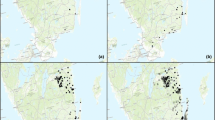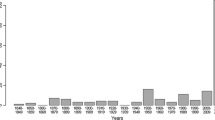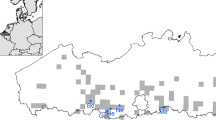Abstract
Pheromone-based monitoring could be a very efficient method to assess the conservation status of rare and elusive insect species, but there are still few studies for which pheromone traps have been used to obtain information on presence, abundance, phenology and movements of such insects. We performed a mark-recapture study of two threatened saproxylic beetles, Osmoderma eremita (Scarabaeidae) and its predator Elater ferrugineus (Elateridae), in two beech forests of central Italy using pheromone baited window traps and unbaited pitfall traps. Two lures were used: (1) the male-produced sex pheromone of O. eremita (racemic γ-decalactone) to attract females of both species, and (2) the female-produced sex pheromone of E. ferrugineus (7-methyloctyl (Z)-4-decenoate), to attract conspecific males. In total, 13 O. eremita and 1,247 E. ferrugineus individuals were trapped. For E. ferrugineus, males were detected earlier than females, and 7-methyloctyl (Z)-4-decenoate was much more efficient lure compared to racemic γ-decalactone in detecting its presence. The population size at the two sites were estimated to 520 and 1,369 individuals, respectively. Our model suggests a sampling effort of ten traps checked for 3 days being sufficient to detect the presence of E. ferrugineus at a given site. The distribution of dispersal distances for the predator was best described by the negative exponential function with 1 % of the individuals dispersing farther than 1,600 m from their natal site. In contrast to studies on these beetles in Northern Europe, the activity pattern of the two beetle species was not influenced by variation in temperature during the season.



Similar content being viewed by others
References
Alexander KNA (2008) Tree biology and saproxylic Coleoptera: issues of definitions and conservation language. Rev Écol (Terre Vie) 63:1–6
Amstrup SC, McDonald TL, Manly BFJ (2005) Handbook of capture-recapture analysis. Princeton University Press, Princeton
Andresson K, Bergman KO, Andersson F, Hedenström E, Jansson N, Burman J, Winde I, Larsson MC, Milberg P (2014) High-accuracy sampling of the saproxylic diversity indicators at regional scales with pheromones: the case of Elater ferrugineus (Coleoptera. Biol Conserv, Elateridae). doi:10.1016/j.biocon.2014.01.007
Anonymous (1992) Directive 92/43 of the Council of the European Community on the conservation of habitats and wild fauna and flora. European Community, Brussels
Anton S, Dufour MC, Gadenne C (2007) Plasticity of olfactory-guided behaviour and its neurobiological basis: lessons from moths and locusts. Entomol Exp Appl 123:1–11. doi:10.1111/j.1570-7458.2007.00516.x
Arakaki N, Nagayama A, Kobayashi A, Tarora K, Kishita M, Sadoyama Y, Mougi N, Kijima K, Suzuki Y, Akino T, Yasui H, Fukaya M (2008) Estimation of abundance and dispersal distance of the sugarcane click beetle Melanotus sakishimensis Ohira (Coleoptera: Elateridae) on Kurima Island, Okinawa, by mark-recapture experiments. Appl Entomol Zool 43:409–419. doi:10.1303/aez.2008.409
Barbour JD, Millar JG, Rodstein J, Ray AM, Alston DG, Rejzek M, Dutcher JD, Hanks LM (2011) Synthetic 3, 5-dimethyldodecanoic acid serves as a general attractant for multiple species of prionus(Coleoptera: Cerambycidae). Ann Entomol Soc Am 104:588–593. doi:10.1603/AN10182
Blackshaw RP, Vernon RS (2006) Spatiotemporal stability of two beetle populations in non-farmed habitats in an agricultural landscape. J Appl Ecol 43:680–689. doi:10.1111/j.1365-2664.2006.01167.x
Boyce MS (1992) Population viability analysis. Annu Rev Ecol Syst 23:481–497
Brouwers NC, Newton AC (2009) Movement rates of woodland invertebrates: a systematic review of empirical evidence. Insect Conserv Diver 2:10–22. doi:10.1111/j.1752-4598.2008.00041.x
Burnham KP, Anderson DR (2002) Model selection and multimodel inference: a practical information-theoretic approach. Springer, Berlin
Butenandt A, Beckmann R, Stamm D, Hecker E (1959) Über den Sexual-Lockstoff des Seidenspinners Bombyx mori. Reindarstellung und Konstitution. Z. Naturforsch. 14b:283–284
Chapman JW, Birkett MA, Pickett JA, Woodcock CM, Wood PJ (2002) Chemical ecology and conservation of the stag beetle, Lucanus cervus. In: Hardie J, Tosh CR, Powell G A8–chemical communication: from hormones to semiochemicals. Abstracts/Comparative Biochemistry and Physiology Part A. vol 132, p S63
Chiari S, Carpaneto GM, Zauli A, Marini L, Audisio P, Ranius T (2012) Habitat of an endangered saproxylic beetle, Osmoderma eremita, in Mediterranean woodlands. Écoscience 19:299–307. doi:10.2980/19-4-3505
Chiari S, Zauli A, Mazziotta A, Luiselli L, Audisio P, Carpaneto GM (2013a) Surveying an endangered saproxylic beetle, Osmoderma eremita, in Mediterranean woodlands: a comparison between different capture methods. J Insect Conserv 17:171–181. doi:10.1007/s10841-012-9495-y
Chiari S, Carpaneto GM, Zauli A, Zirpoli G, Audisio P, Ranius T (2013b) Dispersal patterns of a saproxylic beetle, Osmoderma eremita, in Mediterranean woodlands. Insect Conserv Diver 6:309–318. doi:10.1111/j.1752-4598.2012.00215.x
Chiari S, Bardiani M, Zauli A, Hardersen S, Mason F, Spada L, Campanaro A (2013c) Monitoring of the saproxylic beetle Morimus asper (Sulzer, 1776) (Coleoptera: Cerambycidae) with freshly cut log piles. J Insect Conserv. doi:10.1007/s10841-013-9606-4
Craig CC (1953) On the utilization of marked specimens in estimating population of living insects. Biometrika 40:170–176
Davies ZG, Tyler C, Stewart GB, Pullin AS (2008) Are current management recommendations for saproxylic invertebrates effective? A systematic review. Biodivers Conserv 17:209–234. doi:10.1007/s10531-007-9242-y
Drag L, Hauck D, Pokluda P, Zimmermann K, Cizek L (2011) Demography and dispersal ability of a threatened saproxylic beetle: a mark-recapture study of the Longicorn Rosalia (Rosalia alpina). PLoS ONE 6:e21345. doi:10.1371/journal.pone.0021345
Gouix N, Brustel H (2012) Emergence trap, a new method to survey Limoniscus violaceus (Coleoptera: Elateridae) from hollow trees. Biodivers Conserv 21:421–436. doi:10.1007/s10531-011-0190-1
Grove SJ (2002) Saproxylic insect ecology and the sustainable management of forests. Annu Rev Ecol Syst 33:1–23. doi:10.1146/annurev.ecolsys.33.010802.150507
Gullan PJ, Cranston PS (2010) The insects: an outline of entomology, 4th edition. Wiley-Blackwell, New York
Hartl DL, Clark AG (2007) Principles of population genetics, 4th edn. Sinauer Associates Inc. Publishers, Sunderland, MA
Harvey D, Hawes CJ, Gange AC, Finch P, Chesmore D, Farr I (2011) Development of non-invasive monitoring methods for larvae and adults of the stag beetle. Lucanus cervus Insect Conserv Diver 4:4–14. doi:10.1111/j.1752-4598.2009.00072.x
Hedin J, Ranius T, Nilsson SJ, Smith HG (2008) Restricted dispersal in a flying beetle assessed by telemetry. Biodiv Conserv 17(3):675–684. doi:10.1007/s10531-007-9299-7
Hines JE, MacKenzie DI (2004) PRESENCE, vers. 4.0. http://www.mbr-pwrc.usgs.gov/software.html
Iablokoff AK (1943) Ethologie de quelques élaterides du massif de Fontainebleau. Mem Mus Natl Hist Nat (France) 18:83–160
Larsson MC, Svensson GP (2009) Pheromone monitoring of rare and threatened insects: exploiting a pheromone-kairomone system to estimate prey and predator abundance. Conserv Biol 23:1516–1525. doi:10.1111/j.1523-1739.2009.01263.x
Larsson MC, Svensson GP (2011) Monitoring spatiotemporal variation in abundance and dispersal by a pheromone-kairomone system in the threatened saproxylic beetles Osmoderma eremita and Elater ferrugineus. J Insect Conserv 15:891–902. doi:10.1007/s10841-011-9388-5
Larsson MC, Hedin J, Svensson GP, Tolasch T, Francke W (2003) Characteristic odor of Osmoderma eremita identified as male-released pheromone. J Chem Ecol 29:575–587
Lira PK, Fernandez FA (2009) A comparison of trapping- and radiotelemetry-based estimates of home range of the neotropical opossum Philander frenatus. Mamm Biol 74:1–8. doi:10.1016/j.mambio.2008.05.002
López-Pantoja G, Nevado LD, Sánches-Osorio I (2008) Mark-recapture estimates of survival and recapture rates of Cerambyx welensii Küster (Coleoptera cerambycidae) in a cork oak dehesa in Huelva (Spain). Cent Eur J Biol 3:431–441. doi:10.2478/s11535-008-0044-3
López-Pantoja G, Dominguez L, Sánches-Osorio I (2011) Analysis of Prinobius myardi Mulsant population dynamics in a Mediterranean cork oak stand. Ann soc entomol Fr 47:260–268. doi:10.1080/00379271.2011.10697717
MacKenzie I, Royle JA (2005) Designing occupancy studies: general advice and allocating survey effort. J Appl Ecol 42:1105–1114. doi:10.1111/j.1365-2664.2005.01098.x
Magri D (1998) Quaternary history of Fagus in the Italian peninsula. Annali Botanica 56:147–154
Magri D (2008) Patterns of post-glacial spread and the extent of glacial refugia of European beech (Fagus sylvatica). J Biogeogr 35:450–463. doi:10.1111/j.1365-2699.2007.01803.x
Millar JG, McElfresh JS, Romero C, Vila M, Marí-Mena N, Lopez-Vaamonde C (2010) Identification of the sex pheromone of a protected species, the Spanish Moon Moth Graellsia isabellae. J Chem Ecol 36:923–932. doi:10.1007/s10886-010-9831-1
Morbey YE, Ydenberg RC (2001) Protandrous arrival timing to breeding areas: a review. Ecol Lett 4:663–673. doi:10.1046/j.1461-0248.2001.00265.x
Musa N, Andersson K, Burman J, Andersson F, Hedenström E, Jansson N, Paltto H, Westerberg L, Winde I, Larsson MC, Bergman K, Milberg P (2013) Using sex pheromone and a multi-scale approach to predict the distribution of a rare Saproxylic Beetle. PLoS ONE 8:e66149. doi:10.1371/journal.pone.0066149
Nichols JD, Bailey LL, O’Connell AF Jr, Talancy NW, Grant EHC, Gilbert AT, Annand EM, Husband TP, Hines JE (2008) Multi-scale occupancy estimation and modeling using multiple detection methods. J App Ecol 45:1321–1329. doi:10.1111/j.1365-2664.2008.01509.x
Nieto A, Alexander KNA (2010) European Red List of Saproxylic Beetles. Publications Office of the European Union, Luxembourg
Piovesan G, Alessandrini A, Biondi F, Di Filippo A, Schirone B, Ziaco E (2011) Bioclimatology, growth processes, longevity and structural attributes in Italian network of old-growth beech forests spreading from the Alps to the Appennines. Knapp HD, Fichtner A (eds) Beech forests natural heritage of Europe. Workshop at the International Academy for Nature Conservation. Isle of Vilm, Germany, 19–22 October 2010
Platia G (1994) Fauna d’Italia. Coleoptera Elateridae. Ed. Calderini, Bologna
Ranius T (2000) Minimum viable metapopulation size of a beetle, Osmoderma eremita, living in tree hollows. Anim Conserv 3:37–43. doi:10.1111/j.1469-1795.2000.tb00085.x
Ranius T (2001) Constancy and asynchrony of Osmoderma eremita populations in tree hollows. Oecologia 126:208–215. doi:10.1007/s004420000515
Ranius T (2002) Osmoderma eremita as an indicator of species richness of beetles in tree hollows. Biodiv Conserv 11:931–941. doi:10.1023/A:1015364020043
Ranius T (2006) Measuring the dispersal of saproxylic insects: a key characteristic for their conservation. Popul Ecol 48:177–188. doi:10.1007/s10144-006-0262-3
Ranius T, Hedin J (2001) The dispersal rate of a beetle, Osmoderma eremita, living in tree hollows. Oecologia 126:363–370. doi:10.1007/s004420000529
Ranius T, Nilsson SG (1997) Habitat of Osmoderma eremita Scop. (Coleoptera: Scarabaeidae), a beetle living in hollow trees. J Insect Conserv 1:193–204. doi:10.1023/A:1018416000766
Rink M, Sinsch U (2007) Radio-telemetric monitoring of dispersing stag beetles: implications for conservation. J Zool 272:235–243. doi:10.1111/j.1469-7998.2006.00282.x
Schaffrath U (2003b) Zu Lebensweise, Verbreitung und Gefährdung von Osmoderma eremita (Scopoli, 1763) (Coleoptera; Scarabaeoidea, Cetoniidae, Trichiinae) [Biology, distribution and threat of Osmoderma eremita (Scopoli, 1763) (Coleoptera; Scarabaeoidea, Cetoniidae, Trichiinae)]. Teil 2—Philippia 10:249–336 (in German)
Schallhart N, Wallinger C, Juen A, Traugott M (2009) Dispersal abilities of adult click beetles in arable land revealed by analysis of carbon stable isotopes. Agr For Entomol 11:333–339. doi:10.1111/j.1461-9563.2009.00428.x
Speight MCD (1989) Sasproxylic invertebrates and their conservation. Nature and Environment Series 46, Council of Europe, Strasbourg
Stockland JN, Siitonen J, Jonsson BG (2012) Biodiversity in dead wood. Cambridge University Press, Cambridge. doi:10.1017/CBO9781139025843
Svensson GP, Larsson MC (2008) Enantiomeric specificity in a pheromone-kairomone system of two threatened saproxylic beetles, Osmoderma eremita and Elater ferrugineus. J Chem Ecol 34:189–197. doi:10.1007/s10886-007-9423-x
Svensson GP, Larsson MC, Hedin J (2003) Air sampling of its pheromone to monitor the occurrence of Osmoderma eremita, a threatened beetle inhabiting hollow trees. J Insect Conserv 7:189–198. doi:10.1023/B:JICO.0000020896.71333.f6
Svensson GP, Larsson MC, Hedin J (2004) Attraction of the larval predator Elater ferrugineus to the sex pheromone of its prey, Osmoderma eremita, and its implication for conservation biology. J Chem Ecol 30:353–363. doi:10.1023/B:JOEC.0000017982.51642.8c
Svensson G, Oleksa A, Gawroński R, Lassance JM, Larsson MC (2009) Enantiomeric conservation of the male-produced sex pheromone facilitates monitoring of threatened European hermit beetles (Osmoderma spp). Entomol Exp Appl 133(3):276–282. doi:10.1111/j.1570-7458.2009.00923.x
Svensson GP, Sahlin U, Brage B, Larsson MC (2011) Should I stay or should I go? Modelling dispersal strategies in saproxylic insects based on pheromone capture and radio telemetry: a case study on the threatened hermit beetle Osmoderma eremita. Biodivers Conserv 20:2883–2902. doi:10.1007/s10531-011-0150-9
Svensson GP, Liedtke C, Hedenström E, Breistein P, Bång J, Larsson MC (2012) Chemical ecology and insect conservation: optimising pheromone-based monitoring of the threatened saproxylic click beetle Elater ferrugineus. J Insect Conserv 16:549–555. doi:10.1007/s10841-011-9440-5
Thomas SL, Wagner RG, Halteman WA (2009) Influence of harvest gaps and coarse woody material on click beetles (Coleoptera: Elateridae) in Maine’s Acadian forest. Biodivers Conserv 18:2405–2419. doi:10.1007/s10531-009-9597-3
Tolasch T, Fragstein M, Steidle JLM (2007) Sex pheromone of Elater ferrugineus L. (Coleoptera: Elateridae). J Chem Ecol 33:2156–2166. doi:10.1007/s10886-007-9365-3
Torres-Vila LM, Sanchez-González Á, Ponce-Escudero F, Martín-Vertedor D, Ferrero-García JJ (2012) Assessing mass trapping efficiency and population density of Cerambyx welensii Küster by mark-recapture in dehesa open woodlands. Eur J For Res. doi:10.1007/s10342-011-0579-0
Ufficio Idrografico (2013) Allumiere termo-pluvio database. http://www.idrografico.roma.it/annali/. Accessed 12 Dec 2013
Witzgall P, Kirsch P, Cork A (2010) Sex pheromones and their impact on pest management. J Chem Ecol 36:80–100. doi:10.1007/s10886-009-9737-y
Wunderground (2013) Historical whether database, Caprarola, meteo station ILAZIOCA3. http://www.wunderground.com/history/. Accessed 12 Dec 2013
Yamamura K, Kishita M, Arakari N, Kawamura F, Sadoyama Y (2003) Estimation of dispersal distance by mark-recapture experiments using traps: correction of bias caused by the artificial removal by traps. Popul Ecol 45:149–155
Ziaco E, Di Filippo A, Alessandrini A, Baliva M, D’Andrea E, Piovesan G (2012) Old-growth attributes in a network of Appennines (Italy) beech forests: disentangling the role of past human interferences and biogeoclimate. Plant Biosyst 146:153–166. doi:10.1080/11263504.2011.650729
Acknowledgments
We sincerely thank Lara Redolfi De Zan, Giovanni Luca Scardaci, Francesca Bellotti, Emanuela Maurizi, Chiara Totta, Filippo Bianchi, Giacomo Cavalieri D’Oro, Fabio Turchetti, Sergio Muratore for field assistance. We are grateful to the management authorities of the two SCI investigated, “Boschi mesofili di Allumiere” (Università Agraria di Allumiere) and “Monte Fogliano e Monte Venere” (Riserva Naturale Regionale Lago di Vico), for authorizations and facilities. We also thank Fredrik Andersson for providing the synthetic 7-methyloctyl (Z)-4-decenoate used in this work. The work of SC is supported by the VABAS project.
Author information
Authors and Affiliations
Corresponding author
Rights and permissions
About this article
Cite this article
Zauli, A., Chiari, S., Hedenström, E. et al. Using odour traps for population monitoring and dispersal analysis of the threatened saproxylic beetles Osmoderma eremita and Elater ferrugineus in central Italy. J Insect Conserv 18, 801–813 (2014). https://doi.org/10.1007/s10841-014-9687-8
Received:
Accepted:
Published:
Issue Date:
DOI: https://doi.org/10.1007/s10841-014-9687-8




